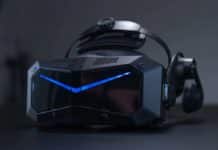Last Update on November 17, 2025
The PlayStation VR2 (PS VR2) is Sony’s latest virtual reality headset, designed exclusively for the PlayStation 5. Launched on February 22, 2023, it brings major improvements over the original PSVR, offering higher resolution, advanced tracking, and deeper immersion. With features like 4K OLED displays, eye tracking, haptic feedback, and a simplified single-cable connection, the PS VR2 redefines VR gaming on consoles.
But what exactly sets it apart from its predecessor? Let’s take a closer look at its key advancements.
Technical Specifications
The PlayStation VR2 brings major hardware improvements for a sharper, smoother, and more immersive VR experience.
- Display: Dual OLED screens (2000 x 2040 per eye) with HDR, a 110° field of view, and 90Hz/120Hz refresh rates for crisp and fluid visuals.
- Tracking: Inside-out tracking eliminates the need for external cameras, while eye tracking enables foveated rendering for better performance.
- Haptic Feedback: The headset vibrates for added immersion, making explosions, tension, and environmental effects more realistic.
- 3D Audio: Tempest 3D AudioTech enhances spatial awareness for a more immersive sound experience.
- Connectivity: A single USB-C cable simplifies setup, making it easier and faster to start playing.
PS VR2 Sense Controllers
A key part of the PlayStation VR2 experience is the PS VR2 Sense controllers, designed to provide more precise, immersive interactions in virtual worlds. These controllers replace the PlayStation Move wands from the original PS VR and introduce advanced features that enhance gameplay realism.
In this section, we’ll explore the main innovations that make the PSVR2 Sense controllers a game-changer for VR gaming.
Adaptive Triggers & Haptic Feedback
The PS VR2 Sense controllers integrate the same adaptive triggers and haptic feedback found in the DualSense controller, allowing for:
- Variable trigger resistance, making actions like pulling a bowstring or firing a gun feel more realistic.
- Detailed vibrations, providing tactile feedback for in-game interactions—such as feeling the texture of objects or the impact of an explosion.
Finger Touch Detection
One of the most innovative additions is finger touch detection, which allows the controllers to sense finger placement without pressing buttons. This means:
- You can naturally move your fingers in-game for more expressive hand gestures.
- Interactions feel more intuitive, such as picking up objects, pointing, or making a fist.
Ergonomic Design & Motion Tracking
The PS VR2 Sense controllers feature a rounded, balanced design that improves comfort and precision. Key elements include:
- A secure grip, designed for extended VR sessions.
- A ring-based tracking system, allowing the PS VR2’s inside-out tracking cameras to accurately follow hand movements without external sensors.
This improved tracking system ensures smooth, responsive gameplay, making interactions more precise and natural.
Game Compatibility & Library
A VR headset is only as good as its game library, and the PlayStation VR2 offers an impressive lineup of exclusive titles, enhanced experiences, and future expansions. While it does not support original PS VR games, its selection of next-gen VR titles takes full advantage of the new hardware.
Exclusive & Enhanced Titles
The PS VR2 launched with several high-profile exclusives and VR-enhanced versions of popular games, including:
- Horizon Call of the Mountain – A flagship VR adventure built specifically for PSVR2, offering breathtaking visuals and full-scale exploration in the Horizon universe.
- Gran Turismo 7 (VR Mode) – A fully immersive racing experience, where players can feel every turn and acceleration with the help of haptic feedback and 3D audio.
- Resident Evil Village (VR Mode) – The terrifying survival horror experience gets a new level of realism, allowing players to physically aim, reload, and interact with their environment.
Other major titles include No Man’s Sky VR, Star Wars: Tales from the Galaxy’s Edge, and The Walking Dead: Saints & Sinners – Chapter 2.
Setup & Connectivity

Setting up the PlayStation VR2 is easier than ever, thanks to its streamlined design and single-cable connection. Unlike the original PS VR, which required multiple cables and an external processor unit, the PS VR2 connects directly to the PlayStation 5 via a single USB-C cable.
Quick & Simple Installation
Getting started with PS VR2 takes just a few steps:
- Connect the headset – Plug the USB-C cable into the front port of the PS5.
- Adjust the fit – Use the adjustable headband and lens dial to find the most comfortable and clear view.
- Run the setup process – The PS5 will guide you through eye tracking calibration, play area customization, and controller pairing.
- Jump into VR – Once configured, players can launch VR-supported games and start playing instantly.
The inside-out tracking system eliminates the need for external cameras, making setup faster and hassle-free.
Using PS VR2 on PC (Limited Compatibility)
Sony has introduced an official adapter allowing the PS VR2 to work on PC, expanding its functionality beyond the PS5. However, some features like eye tracking and HDR are not supported when used on a PC. Players can still access PC VR games via SteamVR, but the experience is not as optimized as on PS5.
Immersion & Audio Experience
The PlayStation VR2 is designed to offer a deeper level of immersion, combining high-quality visuals, haptic feedback, and advanced 3D audio. These features work together to create a more lifelike and engaging VR experience, making every moment feel more real and interactive.
Haptic Feedback & Eye Tracking: A New Level of Presence
One of the biggest innovations in PS VR2 is its haptic feedback system, which extends beyond the controllers to the headset itself. This allows players to physically feel in-game events, such as:
- Subtle vibrations when a character’s heartbeat accelerates in a tense moment.
- The impact of an explosion or the sensation of an object passing close to your head.
- Environmental effects, like the wind or raindrops, adding a new layer of realism.
Additionally, eye tracking technology enhances immersion by allowing games to respond to where you look, improving character interactions and enabling foveated rendering for sharper visuals where it matters most.
3D Audio
The PS VR2 features Tempest 3D AudioTech, the same advanced sound system found in the PS5, providing a highly realistic audio experience. This technology allows players to:
- Accurately locate sounds in a 360° space, improving spatial awareness in-game.
- Experience directional audio cues, making distant sounds feel far away and nearby ones more intense.
- Feel more connected to the virtual world, as footsteps, voices, and environmental noises react dynamically to player movement.
With haptic feedback and 3D audio working together, the PSVR2 delivers an unmatched level of immersion, making every sound and movement feel more lifelike than ever before.
Market Reception & Sales
The PlayStation VR2 launched with high expectations, offering significant upgrades over its predecessor. While praised for its hardware innovations, the headset faced challenges in terms of sales performance and market positioning.
Initial Reception & Critical Response
At launch, the PSVR2 received positive reviews for its high-resolution OLED display, eye tracking, and haptic feedback. Critics highlighted:
- Superior visual fidelity compared to competing VR headsets.
- Advanced immersion features like headset haptics and adaptive triggers.
- Simplified setup with a single-cable connection to the PS5.
However, some concerns emerged regarding:
- High price ($549.99 at launch), making it more expensive than the PS5 itself.
- Limited game library, with a reliance on VR-enhanced ports rather than original exclusives.
- No backward compatibility, preventing access to the existing PS VR game catalog.
Sales Performance & Sony’s Strategy
Despite its technical strengths, PS VR2 sales were lower than expected. Early reports suggested that Sony reduced production forecasts due to slower demand. Factors contributing to this include:
- A niche VR market, where standalone headsets like the Meta Quest 3 appeal to a broader audience.
- The requirement of a PS5, limiting the potential user base.
- Lack of major VR-exclusive titles driving adoption.
To address these challenges, Sony introduced price cuts and an official PC adapter, expanding the PS VR2’s functionality beyond PlayStation 5 users. While the headset remains a powerful VR device, its long-term success will depend on game support, software updates, and broader accessibility.
If you want to get the PSVR2 at a discounted price, you can check out our article to find out when the different deals take place: VR BlackFriday Deals.
Conclusion
The PlayStation VR2 brings major improvements to console VR, with 4K OLED displays, eye tracking, haptic feedback, and 3D audio, offering a highly immersive experience. Its simplified setup and advanced features make it a strong contender in the VR market.
However, its high price, limited game library, and lack of backward compatibility have slowed adoption. While Sony’s PC support expansion helps broaden its appeal, the success of PSVR2 will depend on continued game development and long-term support.
For PlayStation 5 owners seeking top-tier VR, the PSVR2 is an excellent choice, but its future will rely on stronger software support and a more competitive price.











